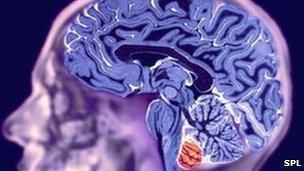Music 'releases mood-enhancing chemical in the brain'
- Published

Music releases a chemical in the brain that has a key role in setting good moods, a study has suggested.
The study, reported in Nature Neuroscience, found that the chemical was released at moments of peak enjoyment.
Researchers from McGill University in Montreal said it was the first time that the chemical - called dopamine - had been tested in response to music.
Dopamine increases in response to other stimuli such as food and money.
It is known to produce a feel-good state in response to certain tangible stimulants - from eating sweets to taking cocaine.
Dopamine is also associated with less tangible stimuli - such as being in love.
In this study, levels of dopamine were found to be up to 9% higher when volunteers were listening to music they enjoyed.
The report authors say it's significant in proving that humans obtain pleasure from music - an abstract reward - that is comparable with the pleasure obtained from more basic biological stimuli.
Music psychologist, Dr Vicky Williamson from Goldsmiths College, University of London welcomed the paper. She said the research didn't answer why music was so important to humans - but proved that it was.
"This paper shows that music is inextricably linked with our deepest reward systems."
Musical 'frisson'
The study involved scanning the brains of eight volunteers over three sessions, using two different types of scan.
The relatively small sample had been narrowed down from an initial group of 217 people.
This was because the participants had to experience "chills" consistently, to the same piece of music, without diminishing on multiple listening or in different environments.
A type of nuclear medicine imaging called a PET scan was used for two sessions. For one session, volunteers listened to music that they highly enjoyed and during the other, they listened to music that they were neutral about.
In the third session the music alternated between enjoyed and neutral, while a functional magnetic resonance imaging, or fMRI scan was made.
Data gathered from the two different types of scans was then analysed and researchers were able to estimate dopamine release.
Dopamine transmission was higher when the participants were listening to music they enjoyed.
Consistent chills
A key element of the study was to measure the release of dopamine, when the participants were feeling their highest emotional response to the music.
To achieve this, researchers marked when participants felt a shiver down the spine of the sort that many people feel in response to a favourite piece of music.
This "chill" or "musical frisson" pinpointed when the volunteers were feeling maxim pleasure.
The scans showed increased endogenous dopamine transmission when the participants felt a "chill". Conversely, when they were listening to music which did not produce a "chill", less dopamine was released.
Dr Robert Zatorre said: "We needed to be sure that we could find people who experienced chills very consistently and reliably.
"That is because once we put them in the scanner, if they did not get chills then we would have nothing to measure.
"The other factor that was important is that we wanted to eliminate any potential confound from verbal associations, so we used only instrumental music.
"This also eliminated many of the original sample of people because the music they brought in that gave them chills had lyrics."
- Published8 January 2010
- Published14 October 2010